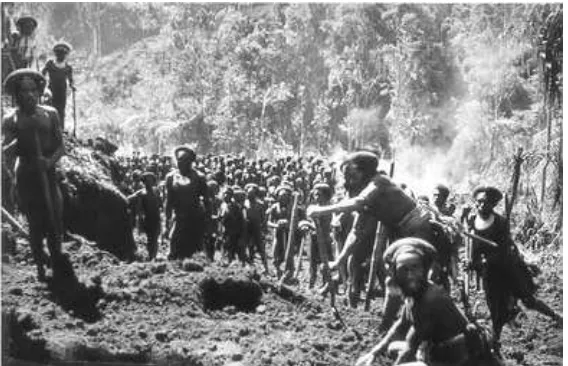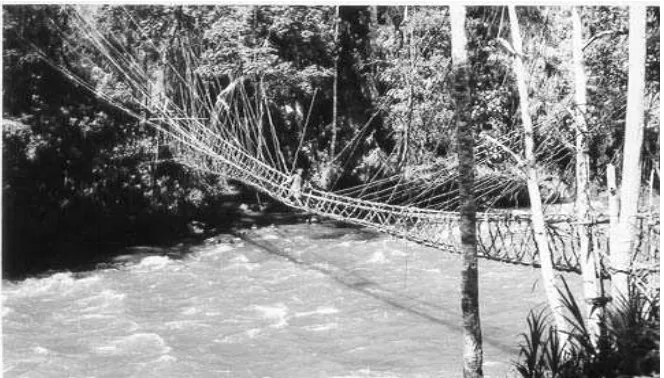Some Kewa Metaphors: Body Parts as Automobile Parts
Karl J. Franklin
Abstract
The Kewa people of the Southern Highlands, Papua New Guinea, saw their first vehicle in 1960. This article demonstrates their creativeness in using metaphors that draw upon body part names and associating those names with certain parts of vehicles.
Eliciting materials in an unfamiliar language can be a daunting task, so it is helpful that body parts are a fairly easy set of terms to note. Not only can one point to many of them, as we did when we first worked monolingually in learning the Kewa language,1 but such terms turn out to be important when expressing emotions and other concepts.2
In Kewa and other languages, body part names are useful metaphors for naming and identifying parts of many other objects, like trees and animals, but also for those
introduced into the culture, such as automobiles or trucks.3 We have observed how Kewa speakers have borrowed or coined names, employing a number of semantic concepts. One of the most common involves metaphors, and speakers do this for automobile parts by analogy to their own bodies.
The first vehicle into the Kewa area was a four-wheel drive, British-made Landrover. In July of 1960, while we were living in the village of Muli in East Kewa, it was taken from Ialibu to Kagua, both government stations. The government officer at Kagua had
requested the vehicle from the Transportation Department in Port Moresby, the capital city. The officials there apparently knew little about the lack of roads in the Southern
1
The Kewa language is spoken by about 100,000 people in three major dialects and is located in the Southern Highlands of Papua New Guinea. The data in this essay are from the Western dialect. I lived with my family in Kewa communities under the auspices of the SIL for nine years between 1958 and 1976.
I collected the data in this essay during discussions and interactions with Wopa Eka, Kenneth Wama and Robert Yomo from the villages of Usa and Sumi. I am grateful to them for their insights, but do not claim that they represent all Kewa villages or dialects, given the variations that so often occur. (See, for example, Franklin 1968 on dialects and Franklin 2003 on variations in counting systems.)
2
I first commented on Kewa body parts (Franklin 1963) in relation to how they seemed to be structured in an anatomical taxonomy. That article was early in our studies of Kewa, and I would now analyze some of the information quite differently. However, that study contributed to my continuing interest in body parts as an essential and initial starting place in a fieldworker’s dictionary (Franklin 1992, unpublished). Additional observations on how the Kewa use metaphors (and other semantic notions) can be found in other
publications, such as Franklin 1970 and 1975.
3
Highlands because, once the vehicle got to Ialibu, there was no road from there to Kagua, a distance of around twenty-five or thirty miles over rough mountainous terrain.
People had heard about vehicles and airplanes and some had seen them. The first vehicle was simply called a su-brrr ‘ground noise’ and complemented the first name for an airplane, yaa-brrr or ‘sky noise’. Any kind of vehicle was later called a dipi ‘jeep’ from Tok Pisin, the primary trade language of New Guinea, and any kind of an airplane was a
balus.4
As indicated, a Kewa person can think of certain parts of an automobile or truck as he or she thinks of parts of a human body. However, although humans have a body (to), the Kewa do not talk about the “body” of a vehicle. They refer instead to its overall structure as its ‘skin’ (yogane), the same word that is used for the ‘bark’ of a tree. I have not yet checked this out, but I would predict that when a vehicle is junked it becomes a ‘corpse’ (ro).
In a human body, the bones (uni) are its structure and metaphorically represent one’s strength. We therefore might expect a vehicle to have ‘bones’ (uni), from which its strength would also be derived. Indeed, the word uni crops up in a number of the expressions for the foundational parts of a vehicle, such as the front and back axles and the wheels. The Kewa people use the word ‘bone’ to signify one’s strength or lack of it in other contexts as well.
The cabin of a car or truck is its ‘head’ (aalu), a word that is used in other non-anatomical contexts, such as ‘a section heading in a paper’.
Not surprisingly, the names for some parts of the human head also occur related to a vehicle. However, such metaphorical extensions are not all associated with the ‘head’ of the vehicle. Those that are include the side-view mirrors, the ‘ears’ (aane); the
windshield, its ‘forehead’ (enoapaa ‘forehead skin/muscle’); and the windshield wipers, its ‘eyelids’ (ini abulu)—all of which are a part of the vehicles ‘head’.
However, the fuel tank is the vehicle’s ‘mouth’ (agaa), which is not a part of the ‘head’. In the same manner, the fuel filter is its ‘tongue’ (eke), the opening to the fuel tank is the ‘lips’ (abulu), the headlights are its ‘eyes’ (ini), and the carburetor is its ‘nose’ (ini kadu).
Other vehicle parts that are described by the human anatomy include the following: the fuel tank is the ‘stomach’ (robaa); the shock absorbers are the ‘kidneys’ (aami repena ini); the gearbox is the ‘heart’ (imu); the back tires are the ‘upper legs’ (ke); the front axle is the ‘hip bone’ (kego uni); the back axle is the ‘shoulder bone’ (pasaa uni); the front tires are the ‘hands and arms’ (ki); the treads on the tires are the ‘finger or toe nails’ (kidipaa apaa); the wheels are the ‘shin bones’ (kidipaauni); the exhaust pipe is the
4
‘intestine’ (lo); the springs are the ‘ribs’ (peraani); the outlet of the exhaust pipe is the ‘anus’ (ikidi); the deck of a truck is its ‘back’ (masaa); the wiring system, including the fan, are the ‘veins’ or ‘tendons’ (kogaapu); the battery is its ‘liver’ (pu); and the oil of a vehicle is its ‘blood’ (yaapi).
Some parts of vehicles have names that are not body parts, but are closely associated with them: animal tusks (imaa), for the ‘bumpers’; the smell of feces (ipuku) for the ‘smell of the exhaust’; the net bag (nu) for the ‘trunk’ of the car; the voice or talk (agaa) for the ‘sound of the engine/ car’; and a yelling noise (rui ta) for the ‘horn.’
From these examples it is clear that the Kewa employ body part names according to their perception of their functions. Their mental image of a body and its parts serve as the imaginative and creative springboard for understanding and naming vehicle parts. Parts of houses and flora have metaphors based on the human body as well. For example, the crown of a tree is represented in Kewa as its ‘neck’ and the sides of a house are its ‘ribs’.
In summary, the way that the Kewa name the parts of a vehicle provide some justification that “the cognitive paradigm sees metaphor as a means whereby ever more abstract and intangible areas of experience can be conceptualized in terms of the familiar and
Appendix A: Alphabetical list of Kewa “body part” terms and their referents
aalu cabin of car/ truck [head]
aami repena ini shock absorbers [kidneys]
aane mirrors [ears]
abulu opening to the fuel tank [lips]
agaa fuel tank [mouth]
agaa noise of vehicle [voice/ talk]
eke fuel filter [tongue]
eno apaa windshield [forehead skin/ muscle]
etaa fuel [food]
i puku smell of exhaust [feces smell]
ikidi outlet of exhaust pipe [anus]
imaa bumper [tusks]
imu gearbox [heart]
iniabulu windshield wipers [eye lids]
ini headlights [eyes]
ini kadu carburetor [nose]
ke back tires [upper legs]
kego uni front axle [hip bone]
ki front tires [hands and arms]
kidipaaapaa tires/ treads of tire [finger nails]
kidipaa uni wheels [shin bones]
kogaapu wiring/ fan [veins]
lo exhaust pipe [intestine]
masaa deck of truck [back]
nu trunk [net bag]
pasaa uni back axle [shoulder bone]
Appendix B: The first road and vehicle in the Kewa area (July 1960). Photos by the author.
Although the names for parts of a vehicle are body parts as extended metaphorical lexical items, many of the words related to roadwork are simply borrowed from Tok Pisin, such as spet for ‘shovel’ and ba for ‘crowbar’.
Figure 1 shows the Kewa men working with traditional garden digging sticks (lama) and axes (rai), but the government also gave them shovels, spades and crowbars.
Figure 1. Kewa men working on the Ialibu-Kagua road (July 1960).
Several hundred men were conscripted or volunteered to pull the first vehicle through dense grasslands, wild cane, scrub bush, and steep terrain. Several rivers needed to be crossed, including the large Iaro River that lies between Ialibu and Kagua. Figure 2 (below) was taken as the vehicle was being pulled through the Kuni Creek, near Muli. The man at the side of the vehicle is the government officer who “drove” the Landrover (when it was moving).
Figure 3. Pulling the Landrover through wild cane and grass (July 1960).
Most of the road had not been surveyed, especially from Muli on to Kagua, the government station south of Ialibu. In Figure 3, the man standing near the front of the vehicle is an interpreter (tanim tok, Tok Pisin) and the man at the lower right foreground with dark clothes but without a wig is a policeman. The government officer (kiap, Tok Pisin) is standing to the left of the Landrover with his hands on his sides.
A further note: It took two days for the Kewa men to construct a temporary bridge of rocks through the Iaro River (shown below with a vine bridge over it), which is about 150 feet wide and four to five feet deep at the place where the Landrover crossed (and near where there is now a permanent bridge). The concept of a bridge (ro, the same word as for ‘corpse’ because bodies were traditionally suspended from two poles during the mourning period) was related to vine bridges or logs across streams. Rivers flood quickly in the area, but the Landrover was brought in during the driest period of the year.
References
Franklin, Karl J. 1963. Ethnolinguistic concepts of Kewa body parts. Southwest Journal of Anthropology 19:54–63.
Franklin, Karl J. 1968. The dialects of Kewa. Pacific Linguistics B 10.
Franklin, Karl J. 1970. Metaphorical songs in Kewa. Pacific Linguistics C 13:985–995. Franklin Karl J. 1975. A Kewa religious argot. Anthropos 70:713–725.
Franklin, Karl J. 1992. Using body parts to start a dictionary. Unpublished.
Franklin, Karl J. 2003. Tagmemic insights on Kewa numbers and names. In Mary Ruth Wise, Thomas N. Headland, and Ruth M. Brend (eds.), Language and life: Essays in memory of Kenneth L. Pike. Dallas: SIL International. Forthcoming.
Lakoff, George and Mark Johnson. 1980. Metaphors we live by. Chicago: University of Chicago Press.

